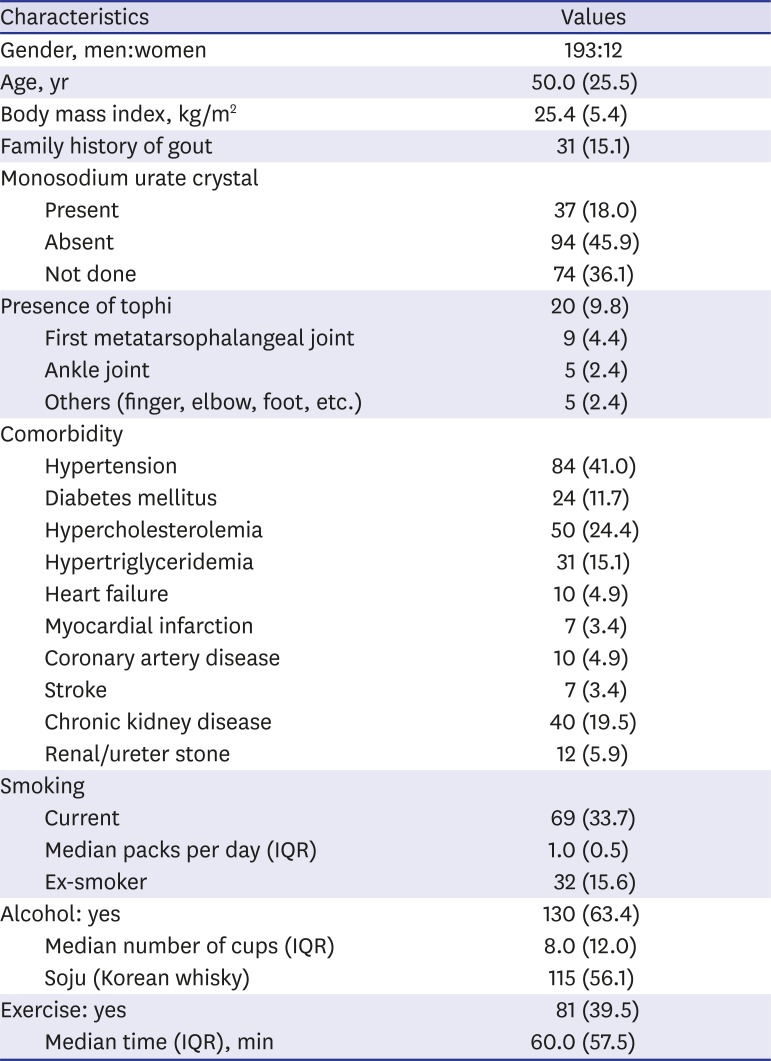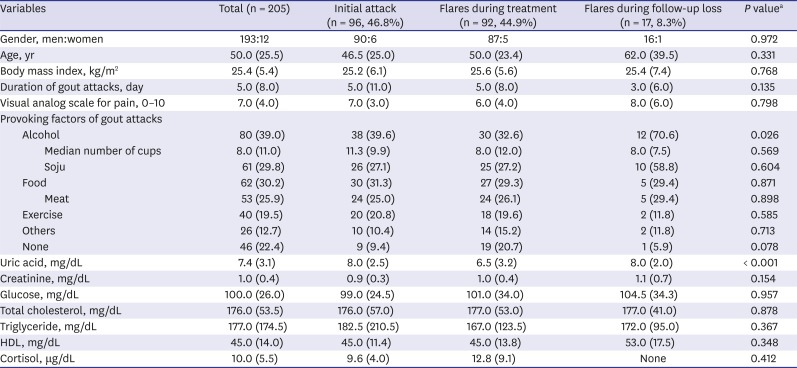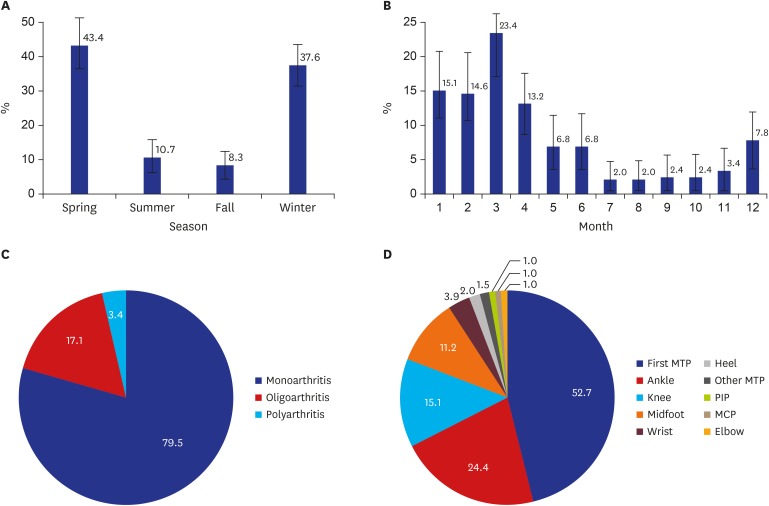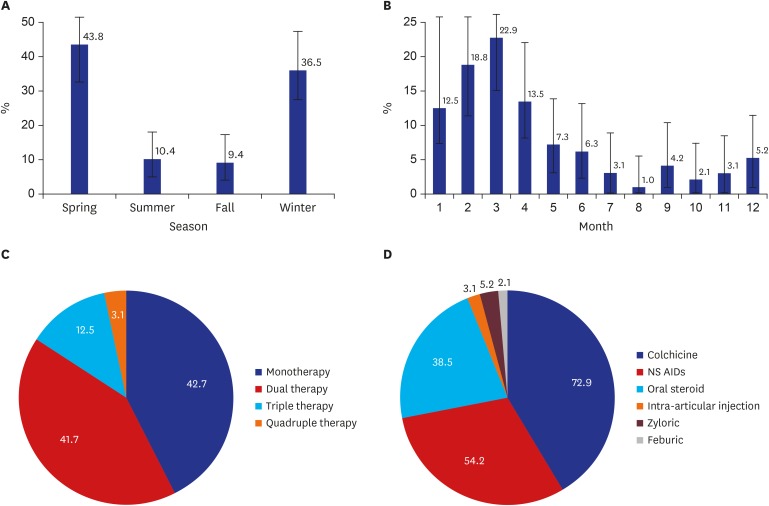1. Robinson PC, Kempe S, Tebbutt I, Roberts L. Epidemiology of inpatient gout in Australia and New Zealand: temporal trends, comorbidities and gout flare site. Int J Rheum Dis. 2017; 20(6):779–784. PMID:
27455925.

2. Annemans L, Spaepen E, Gaskin M, Bonnemaire M, Malier V, Gilbert T, et al. Gout in the UK and Germany: prevalence, comorbidities and management in general practice 2000–2005. Ann Rheum Dis. 2008; 67(7):960–966. PMID:
17981913.

3. Cea Soriano L, Rothenbacher D, Choi HK, García Rodríguez LA. Contemporary epidemiology of gout in the UK general population. Arthritis Res Ther. 2011; 13(2):R39. PMID:
21371293.

4. Xia Y, Wu Q, Wang H, Zhang S, Jiang Y, Gong T, et al. Global, regional and national burden of gout, 1990-2017: a systematic analysis of the Global Burden of Disease Study. Rheumatology (Oxford). 2019; kez476. PMID:
31624843.

5. Choi HJ, Lee CH, Lee JH, Yoon BY, Kim HA, Suh CH, et al. Seasonality of gout in Korea: a multicenter study. J Korean Med Sci. 2015; 30(3):240–244. PMID:
25729244.

6. Schlesinger N. Acute gouty arthritis is seasonal: possible clues to understanding the pathogenesis of gouty arthritis. J Clin Rheumatol. 2005; 11(4):240–242.
7. Wallace SL, Robinson H, Masi AT, Decker JL, McCarty DJ, Yü TF. Preliminary criteria for the classification of the acute arthritis of primary gout. Arthritis Rheum. 1977; 20(3):895–900. PMID:
856219.

8. Schlesinger N, Gowin KM, Baker DG, Beutler AM, Hoffman BI, Schumacher HR Jr. Acute gouty arthritis is seasonal. J Rheumatol. 1998; 25(2):342–344. PMID:
9489831.

9. Arber N, Vaturi M, Schapiro JM, Jelin N, Weinberger A. Effect of weather conditions on acute gouty arthritis. Scand J Rheumatol. 1994; 23(1):22–24. PMID:
8108663.
10. Rovenský J, Mikulecký M, Masárová R. Gout and pseudogout chronobiology. J Rheumatol. 1999; 26(6):1426–1427. PMID:
10381081.
11. Gallerani M, Govoni M, Mucinelli M, Bigoni M, Trotta F, Manfredini R. Seasonal variation in the onset of acute microcrystalline arthritis. Rheumatology (Oxford). 1999; 38(10):1003–1006. PMID:
10534553.

12. Elliot AJ, Cross KW, Fleming DM. Seasonality and trends in the incidence and prevalence of gout in England and Wales 1994–2007. Ann Rheum Dis. 2009; 68(11):1728–1733. PMID:
19029167.

13. Park KY, Kim HJ, Ahn HS, Yim SY, Jun JB. Association between acute gouty arthritis and meteorological factors: An ecological study using a systematic review and meta-analysis. Semin Arthritis Rheum. 2017; 47(3):369–375. PMID:
28583691.

14. Choi HK, Niu J, Neogi T, Chen CA, Chaisson C, Hunter D, et al. Nocturnal risk of gout attacks. Arthritis Rheumatol. 2015; 67(2):555–562. PMID:
25504842.

15. Neogi T, Chen C, Niu J, Chaisson C, Hunter DJ, Choi H, et al. Relation of temperature and humidity to the risk of recurrent gout attacks. Am J Epidemiol. 2014; 180(4):372–377. PMID:
24993733.

16. Choi HK, Liu S, Curhan G. Intake of purine-rich foods, protein, and dairy products and relationship to serum levels of uric acid: the Third National Health and Nutrition Examination Survey. Arthritis Rheum. 2005; 52(1):283–289. PMID:
15641075.

17. Mak A, Ho RC, Tan JY, Teng GG, Lahiri M, Lateef A, et al. Atherogenic serum lipid profile is an independent predictor for gouty flares in patients with gouty arthropathy. Rheumatology (Oxford). 2009; 48(3):262–265. PMID:
19151029.

18. Jung JY, Choi Y, Suh CH, Yoon D, Kim HA. Effect of fenofibrate on uric acid level in patients with gout. Sci Rep. 2018; 8(1):16767. PMID:
30425304.

19. Walker BR, Best R, Noon JP, Watt GC, Webb DJ. Seasonal variation in glucocorticoid activity in healthy men. J Clin Endocrinol Metab. 1997; 82(12):4015–4019. PMID:
9398705.

20. Richette P, Doherty M, Pascual E, Barskova V, Becce F, Castañeda-Sanabria J, et al. 2016 updated EULAR evidence-based recommendations for the management of gout. Ann Rheum Dis. 2017; 76(1):29–42. PMID:
27457514.

21. Sivera F, Andrés M, Carmona L, Kydd AS, Moi J, Seth R, et al. Multinational evidence-based recommendations for the diagnosis and management of gout: integrating systematic literature review and expert opinion of a broad panel of rheumatologists in the 3e initiative. Ann Rheum Dis. 2014; 73(2):328–335. PMID:
23868909.

22. Khanna D, Fitzgerald JD, Khanna PP, Bae S, Singh MK, Neogi T, et al. 2012 American College of Rheumatology guidelines for management of gout. Part 1: systematic nonpharmacologic and pharmacologic therapeutic approaches to hyperuricemia. Arthritis Care Res (Hoboken). 2012; 64(10):1431–1446. PMID:
23024028.

23. Scheepers LE, van Onna M, Stehouwer CD, Singh JA, Arts IC, Boonen A. Medication adherence among patients with gout: a systematic review and meta-analysis. Semin Arthritis Rheum. 2018; 47(5):689–702. PMID:
29198878.

24. Aung T, Myung G, FitzGerald JD. Treatment approaches and adherence to urate-lowering therapy for patients with gout. Patient Prefer Adherence. 2017; 11:795–800. PMID:
28458524.











 PDF
PDF Citation
Citation Print
Print




 XML Download
XML Download